Unit 1 Asia Integrated skills & Study skills 课件(共20张PPT) 牛津译林版九年级英语下册
文档属性
| 名称 | Unit 1 Asia Integrated skills & Study skills 课件(共20张PPT) 牛津译林版九年级英语下册 |  | |
| 格式 | pptx | ||
| 文件大小 | 701.6KB | ||
| 资源类型 | 教案 | ||
| 版本资源 | 牛津译林版 | ||
| 科目 | 英语 | ||
| 更新时间 | 2024-01-12 20:08:30 | ||
图片预览

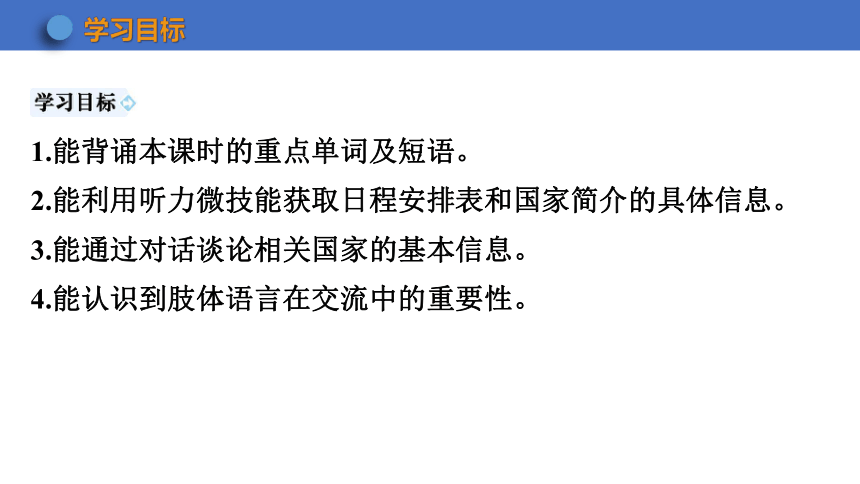
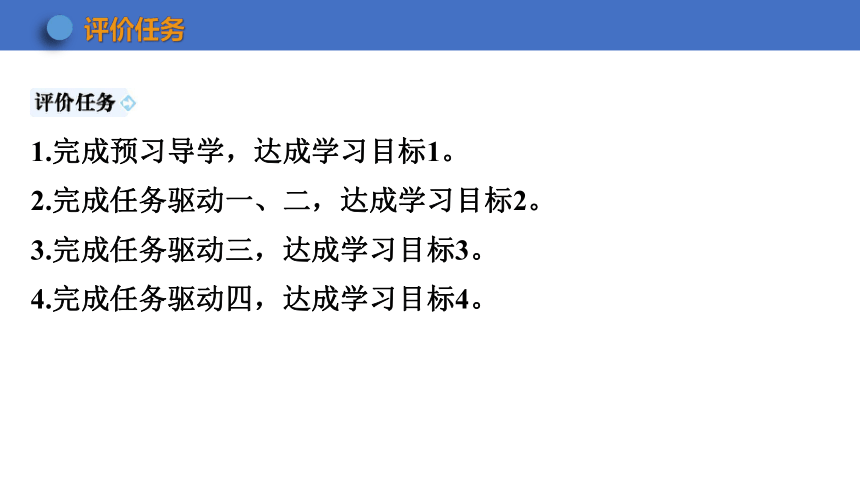
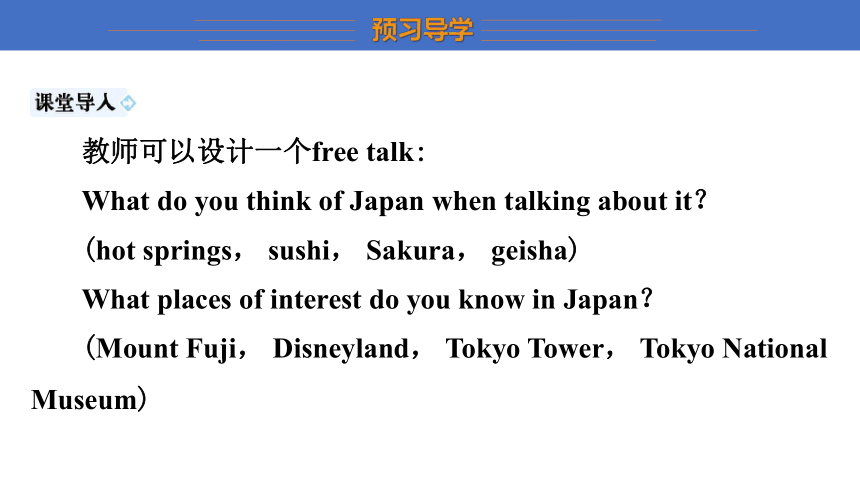
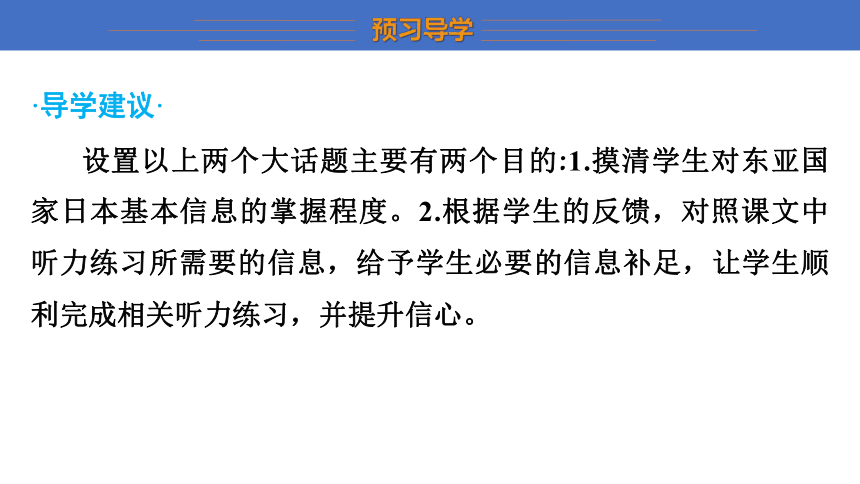
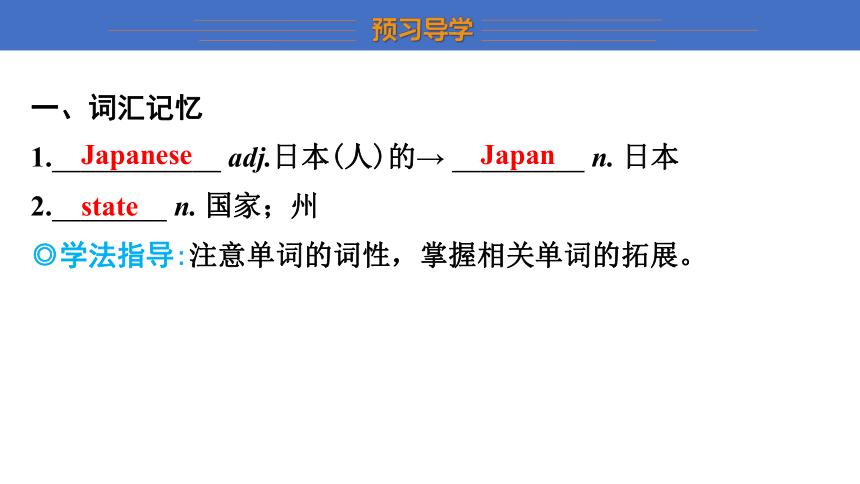
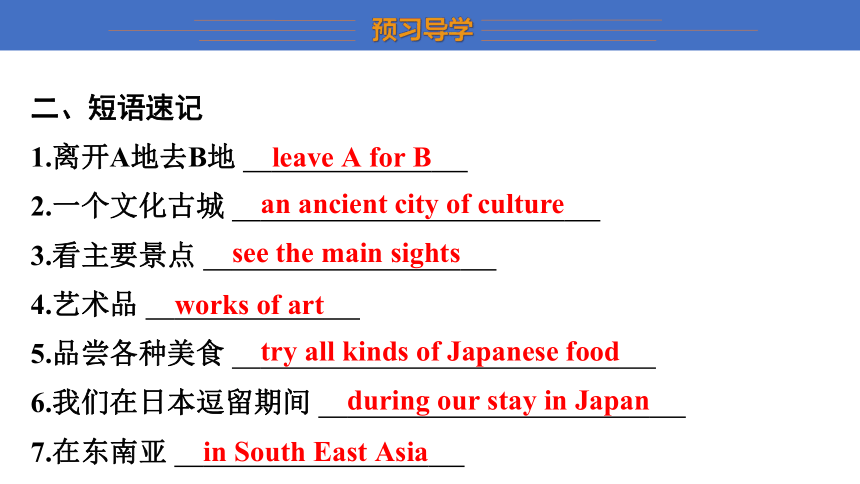
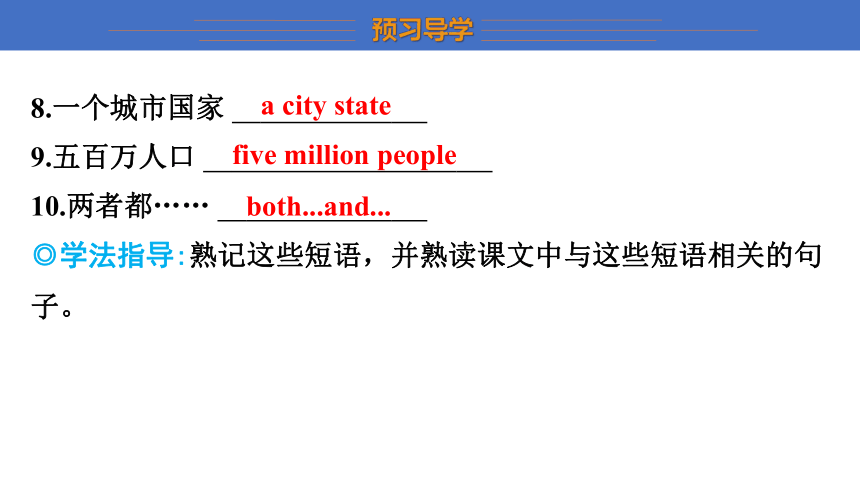
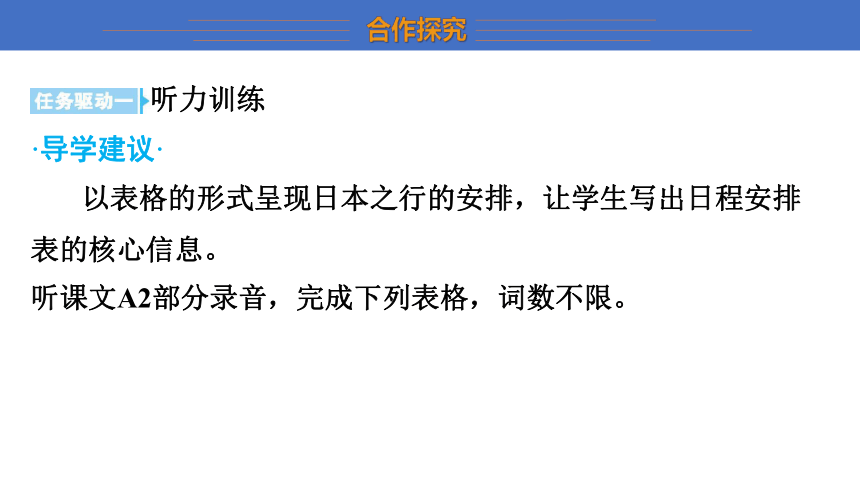
文档简介
(共20张PPT)
九年级·英语·译林版·全一册
Unit 1 Asia
Integrated skills & Study skills
1.能背诵本课时的重点单词及短语。
2.能利用听力微技能获取日程安排表和国家简介的具体信息。
3.能通过对话谈论相关国家的基本信息。
4.能认识到肢体语言在交流中的重要性。
1.完成预习导学,达成学习目标1。
2.完成任务驱动一、二,达成学习目标2。
3.完成任务驱动三,达成学习目标3。
4.完成任务驱动四,达成学习目标4。
教师可以设计一个free talk:
What do you think of Japan when talking about it?
(hot springs, sushi, Sakura, geisha)
What places of interest do you know in Japan?
(Mount Fuji, Disneyland, Tokyo Tower, Tokyo National Museum)
设置以上两个大话题主要有两个目的:1.摸清学生对东亚国家日本基本信息的掌握程度。2.根据学生的反馈,对照课文中听力练习所需要的信息,给予学生必要的信息补足,让学生顺利完成相关听力练习,并提升信心。
·导学建议·
一、词汇记忆
1. Japanese adj.日本(人)的→ Japan n. 日本
2. state n. 国家;州
◎学法指导:注意单词的词性,掌握相关单词的拓展。
Japanese
Japan
state
二、短语速记
1.离开A地去B地 leave A for B
2.一个文化古城 an ancient city of culture
3.看主要景点 see the main sights
4.艺术品 works of art
5.品尝各种美食 try all kinds of Japanese food
6.我们在日本逗留期间 during our stay in Japan
7.在东南亚 in South East Asia
leave A for B
an ancient city of culture
see the main sights
works of art
try all kinds of Japanese food
during our stay in Japan
in South East Asia
8.一个城市国家 a city state
9.五百万人口 five million people
10.两者都…… both...and...
◎学法指导:熟记这些短语,并熟读课文中与这些短语相关的句子。
a city state
five million people
both...and...
听力训练
·导学建议·
以表格的形式呈现日本之行的安排,让学生写出日程安排表的核心信息。
听课文A2部分录音,完成下列表格,词数不限。
The trip to Japan
Introduction Next week, on 1. 25 February , we’re leaving Shanghai for Japan. Our flight will be at nine in the morning.
25 February
Main body Day 1 We can see 2. the main sights and go shopping in the city.
Day 2 We’re going to 3. take a coach to Mount Fuji early in the morning.
Day 3 We’re going to 4. an ancient city called Kyoto.
Conclusion I’m sure we’ll have a nice trip!
the main
take a coach to Mount
an ancient city
Fuji
◎学法指导:首先要思考一下,日程安排表具体特征是什么?会涉及哪些具体的信息?边听边记录相关信息。
听读训练
·导学建议·
与学生共同讨论如何简单地介绍一个国家,可以问一些关于新加坡的常识问题,摸清学生的背景知识,有的放矢,加以铺垫。
听课文B部分Speak up录音,完成下列表格,词数不限。
A trip to Singapore
Location 1. in South East Asia
Area 2. a small city state
Population 3. about five million people
Language 4. both English and Chinese
◎学法指导:独立完成上面的练习,然后积极与同伴探讨如何在听的过程中快速记笔记,并总结经验。
in South East Asia
a small city state
about five million people
both English and Chinese
对话模仿
·导学建议·
让学生根据对话模板和表格内的信息进行对话模仿,鼓励学生自由创作,不必拘泥于模板。
使用下面的信息与模板,两人一组进行对话。
A:Where’s ...,...?
B:It’s in ... ,Asia.
A:It’s very ..., isn’t it?
B:Yes, it is./ No, it isn’t. ( It’s a/an ...)
A:How many people are there in ...?
B:There are about ...people.
A:What languages do they speak?
B:They speak...
◎学法指导:可以根据自己的喜好讨论其他国家,也可以改编对话的模式,增加对话轮次。
Our teacher, Miss Thompson, is also going to take us to the Tokyo National Museum to see some Japanese works of art. 我们的老师,汤普森女士,也将会带我们去东京国立博物馆去看一些日本艺术品。
◎观察思考:
My friend is a little Japanese boy. 我的朋友是一名日本小男孩。
Have you ever been to Japan? 你曾经去过日本吗?
I can speak English but I can’t speak Japanese. 我会说英语,但是我不会说日语。
He fought against the Japanese in the Pacific battle area. 他在太平洋战区与日本人作战。
◎用法总结:
Japan为名词,意为“日本”;后缀-ese表示某国或某地的人及语言,Japanese作形容词时,意为“日本(人)的”;Japanese作名词时,意为“日本人;日语”,用作“日本人”时,单复数同形。
用括号内所给单词的正确形式填空。
1.He speaks English, French, German and Japanese (Japan).
2.A lot of Japanese (Japan) are proud of the works of art in Tokyo National Museum.
Japanese
Japanese
九年级·英语·译林版·全一册
Unit 1 Asia
Integrated skills & Study skills
1.能背诵本课时的重点单词及短语。
2.能利用听力微技能获取日程安排表和国家简介的具体信息。
3.能通过对话谈论相关国家的基本信息。
4.能认识到肢体语言在交流中的重要性。
1.完成预习导学,达成学习目标1。
2.完成任务驱动一、二,达成学习目标2。
3.完成任务驱动三,达成学习目标3。
4.完成任务驱动四,达成学习目标4。
教师可以设计一个free talk:
What do you think of Japan when talking about it?
(hot springs, sushi, Sakura, geisha)
What places of interest do you know in Japan?
(Mount Fuji, Disneyland, Tokyo Tower, Tokyo National Museum)
设置以上两个大话题主要有两个目的:1.摸清学生对东亚国家日本基本信息的掌握程度。2.根据学生的反馈,对照课文中听力练习所需要的信息,给予学生必要的信息补足,让学生顺利完成相关听力练习,并提升信心。
·导学建议·
一、词汇记忆
1. Japanese adj.日本(人)的→ Japan n. 日本
2. state n. 国家;州
◎学法指导:注意单词的词性,掌握相关单词的拓展。
Japanese
Japan
state
二、短语速记
1.离开A地去B地 leave A for B
2.一个文化古城 an ancient city of culture
3.看主要景点 see the main sights
4.艺术品 works of art
5.品尝各种美食 try all kinds of Japanese food
6.我们在日本逗留期间 during our stay in Japan
7.在东南亚 in South East Asia
leave A for B
an ancient city of culture
see the main sights
works of art
try all kinds of Japanese food
during our stay in Japan
in South East Asia
8.一个城市国家 a city state
9.五百万人口 five million people
10.两者都…… both...and...
◎学法指导:熟记这些短语,并熟读课文中与这些短语相关的句子。
a city state
five million people
both...and...
听力训练
·导学建议·
以表格的形式呈现日本之行的安排,让学生写出日程安排表的核心信息。
听课文A2部分录音,完成下列表格,词数不限。
The trip to Japan
Introduction Next week, on 1. 25 February , we’re leaving Shanghai for Japan. Our flight will be at nine in the morning.
25 February
Main body Day 1 We can see 2. the main sights and go shopping in the city.
Day 2 We’re going to 3. take a coach to Mount Fuji early in the morning.
Day 3 We’re going to 4. an ancient city called Kyoto.
Conclusion I’m sure we’ll have a nice trip!
the main
take a coach to Mount
an ancient city
Fuji
◎学法指导:首先要思考一下,日程安排表具体特征是什么?会涉及哪些具体的信息?边听边记录相关信息。
听读训练
·导学建议·
与学生共同讨论如何简单地介绍一个国家,可以问一些关于新加坡的常识问题,摸清学生的背景知识,有的放矢,加以铺垫。
听课文B部分Speak up录音,完成下列表格,词数不限。
A trip to Singapore
Location 1. in South East Asia
Area 2. a small city state
Population 3. about five million people
Language 4. both English and Chinese
◎学法指导:独立完成上面的练习,然后积极与同伴探讨如何在听的过程中快速记笔记,并总结经验。
in South East Asia
a small city state
about five million people
both English and Chinese
对话模仿
·导学建议·
让学生根据对话模板和表格内的信息进行对话模仿,鼓励学生自由创作,不必拘泥于模板。
使用下面的信息与模板,两人一组进行对话。
A:Where’s ...,...?
B:It’s in ... ,Asia.
A:It’s very ..., isn’t it?
B:Yes, it is./ No, it isn’t. ( It’s a/an ...)
A:How many people are there in ...?
B:There are about ...people.
A:What languages do they speak?
B:They speak...
◎学法指导:可以根据自己的喜好讨论其他国家,也可以改编对话的模式,增加对话轮次。
Our teacher, Miss Thompson, is also going to take us to the Tokyo National Museum to see some Japanese works of art. 我们的老师,汤普森女士,也将会带我们去东京国立博物馆去看一些日本艺术品。
◎观察思考:
My friend is a little Japanese boy. 我的朋友是一名日本小男孩。
Have you ever been to Japan? 你曾经去过日本吗?
I can speak English but I can’t speak Japanese. 我会说英语,但是我不会说日语。
He fought against the Japanese in the Pacific battle area. 他在太平洋战区与日本人作战。
◎用法总结:
Japan为名词,意为“日本”;后缀-ese表示某国或某地的人及语言,Japanese作形容词时,意为“日本(人)的”;Japanese作名词时,意为“日本人;日语”,用作“日本人”时,单复数同形。
用括号内所给单词的正确形式填空。
1.He speaks English, French, German and Japanese (Japan).
2.A lot of Japanese (Japan) are proud of the works of art in Tokyo National Museum.
Japanese
Japanese
